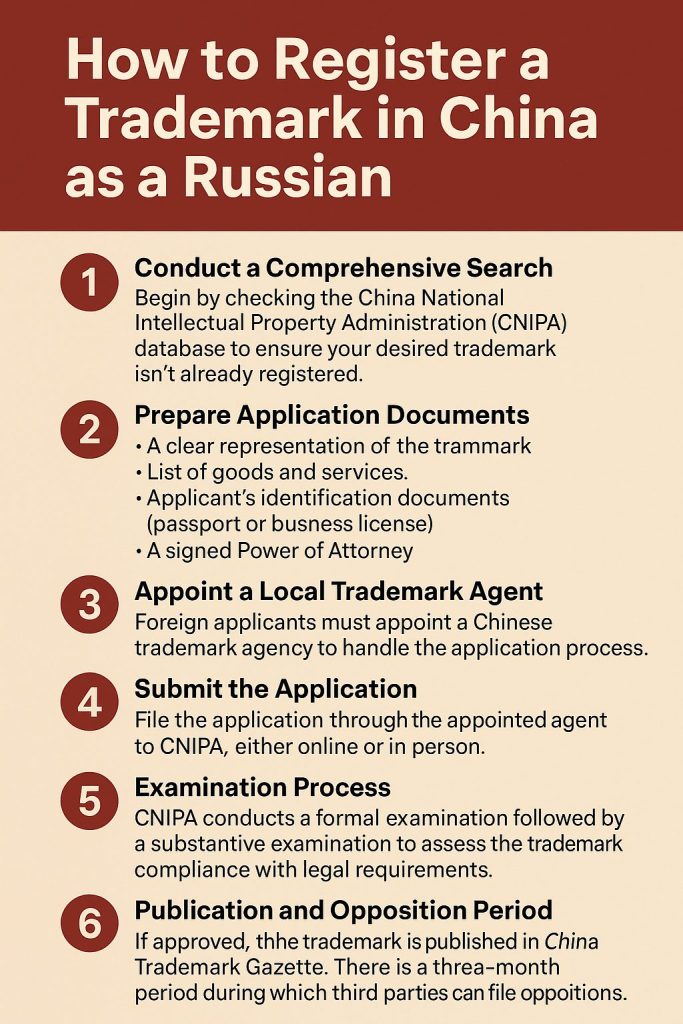Contents
Introduction:
As the world’s second-largest economy with a population of 1.4 billion, China offers enormous commercial potential for Russian enterprises and individuals. Trademark registration in China is a vital step to protect intellectual property and expand market presence. According to data from the China National Intellectual Property Administration (CNIPA) in 2022, 62% of rejected foreign-language trademark applications were due to improper word design, with Cyrillic trademarks facing a rejection rate as high as 89%. Russian applicants using Latin-letter word marks had a first-pass approval rate of up to 78%, nearly three times higher than trademarks in the Russian language. This article provides a comprehensive guide to trademark registration in China for Russian citizens and companies.
1. Eligibility and Requirements for Trademark Registration in China for Russian Applicants
China follows a “first-to-file” principle, meaning that trademark rights are granted to the first person who files an application rather than the first who uses the mark. Therefore, Russian applicants are advised to file their applications as early as possible to avoid trademark squatting. Notably, China adopts the “Nice Classification” system (11th edition), which categorizes trademarks into 45 classes—Classes 1 to 34 for goods and Classes 35 to 45 for services.
Russian individuals and businesses are fully eligible to apply for trademark registration in China. Under the Paris Convention and relevant Chinese laws, foreign applicants are not required to have a business presence in China to file for a trademark. Russian individuals must submit a notarized and legalized copy of their identity documents, while Russian companies only need to provide a clear copy of their company registration certificate. No notarization or legalization is required, as the official trademark agent will prepare the Chinese translation.
Regarding application requirements, trademarks must be distinctive and must not violate Chinese laws or social ethics, nor conflict with prior rights. Special attention should be given to China’s restrictions on certain symbols, such as national flags or emblems, which cannot be registered as trademarks without official authorization.
In terms of language, foreign applicants commonly file in English, but foreign-language versions may also be submitted. Russian applicants should prepare a Chinese translation of the trademark. The translation must not only be accurate but also culturally appropriate for the Chinese market. Some words with positive connotations in Russian may carry negative associations when directly translated into Chinese, which can significantly hinder market reception.
Although Russian applicants can file independently, it is strongly recommended to appoint a qualified trademark agency in China due to potential language barriers, procedural complexity, and cultural differences. Professional agencies like GWBMA can increase approval rates and provide strategic support, such as trademark portfolio planning and defensive registration.
2. Types of Trademarks and Design Guidelines for Trademark Registration in China for Russian Citizens
When registering a trademark in China, applicants must clearly choose a trademark type. According to the Chinese Trademark Law, trademarks are generally classified into the following three categories. Russian applicants should choose according to their business needs:
Word Marks
Definition and Characteristics:
These consist solely of text, including Chinese characters, foreign letters, or numerals. For Russian applicants, using Cyrillic letters entails significant risks:
-
Lack of Distinctiveness: Cyrillic letters are not widely recognized by Chinese consumers and may be rejected as non-distinctive.
-
Review Barriers: CNIPA examiners may struggle to assess pronunciation, meaning, and possible conflicts with existing rights.
-
Poor Market Acceptance: Difficult pronunciation and memorability hinder brand communication.
Design Recommendations:
-
Prioritize Latin Letters: Use English or pinyin (e.g., “VOSTOK” instead of “ВОСТОК”) to retain brand identity while aligning with international business norms.
-
Bilingual Combination: Consider registering combined English-Chinese marks (e.g., “北极星 BEIJIXING”) to meet legal requirements and improve market penetration.
-
Font Style Norms: Avoid overly artistic fonts to ensure legibility. For stylized fonts, it’s advisable to also register a standard version for defensive purposes.
Figurative Marks
Scope of Use:
Consist of geometric shapes, abstract symbols, or specific images—ideal for brands with strong visual identities.
Advantages:
Not bound by language and the protection covers the visual design as a whole.
Risks:
Be aware of cultural differences between Russia and China. For example:
-
Bears may symbolize strength in Russia but could imply aggression in Chinese culture.
-
White symbolizes purity in China but may also be linked to funerals in some contexts.
Design Considerations:
-
Conduct cross-cultural semiotic analysis to avoid religious or political sensitivities.
-
Consider adding English elements to enhance recognizability.
Figurative mark containing word elements
Typical Structure:
Combination of text and images (e.g., Starbucks logo + “STARBUCKS”). Russian applicants should take note of:
-
Separate Registrations: It’s advised to register word and image elements separately. This enables flexible use and protects against partial infringement.
-
Proportion Rules: Chinese text should be no smaller than 3mm. The ratio of text to graphics must comply with the Trademark Examination Guidelines.
-
Color Strategy: Black-and-white registrations cover all color uses. If specific colors (e.g., Russian flag colors) are declared, protection will be limited to those.
3. Pre-Application Strategy for Trademark Registration in China for Russian Individuals and Businesses
Comprehensive trademark searches are the most crucial step for Russian applicants. While GWBMA provides a free online search tool, due to language and legal intricacies, it is highly recommended to engage a local agency like GWBMA for professional assistance. Searches must include identical and similar marks within the same or related classes.
When designing the trademark, Russian applicants should factor in cultural differences. Certain symbols or colors that carry positive meanings in Russia may be interpreted differently in China. For instance, red symbolizes celebration in China but may also imply political connotations. The design should be clean, visually striking, and easily recognizable in the Chinese market.
Choosing the right goods/services classes is particularly critical. While China uses the Nice Classification system, some subclasses may differ from Russian classifications. Applicants should carefully analyze their business scope to identify core and defensive classes. A common mistake is registering only the core class and neglecting related ones, which can lead to trademark hijacking during business expansion.
4. Step-by-Step Process of Trademark Registration in China for Russian Nationals
The following outlines the process for Russian applicants to file a trademark with China’s CNIPA (China National Intellectual Property Administration):
-
Application Submission:
Can be submitted electronically or in paper form. Electronic applications are faster and slightly cheaper. Required documents include the application form, trademark specimen, ID or company registration documents, and their translations. -
Formal Examination:
Takes about 1–3 months to check whether documents are complete and meet formatting requirements. If issues arise, a correction notice will be issued. -
Substantive Examination:
Takes 6–9 months to evaluate whether the trademark meets registration criteria and conflicts with prior rights. Common issues for Russian applicants include lack of distinctiveness and similarity to existing Chinese trademarks. -
Preliminary Publication:
If the application passes, it will be published in the Trademark Gazette for a 3-month opposition period. -
Registration Announcement:
If no opposition is filed or the opposition fails, the trademark is officially registered and a certificate is issued. The registration is valid for 10 years.
The full process typically takes 6–12 months. If rejection or opposition occurs, it may take longer. However, China has introduced reforms to expedite the trademark review process, shortening examination times.
5. Post-Approval Management Tips for Trademark Registration in China for Russian Trademark Owners
After obtaining trademark rights in China, Russian trademark owners should pay attention to the following management issues:
-
Use Requirement:
China requires actual use of trademarks. If a registered trademark is not used for three consecutive years without a valid reason, it may be canceled. Russian owners should ensure use in the Chinese market and retain proof, such as sales contracts, invoices, and promotional materials. -
Renewal Management:
Trademarks are valid for 10 years. Renewal applications must be submitted within 12 months before expiry; a 6-month grace period is allowed. A reminder system should be set up to avoid unintentional expiration. -
Changes and Recordation:
If the Russian owner’s name or address changes, or if licensing occurs, such changes must be filed with CNIPA. Failure to update may result in missed official correspondence. -
Infringement Monitoring:
Trademark infringement is common in China’s vast market. Owners should regularly monitor for violations and take action via administrative complaints or civil litigation. China also offers customs recordation to prevent import/export of counterfeit goods.
6. Common Issues Faced by Russian Applicants and How to Respond in the China Trademark System
Common problems faced by Russian applicants and their solutions include:
-
Language and Cultural Barriers:
Poor translations may lead to rejections or poor market reception. Professional translators and local marketing consultants should be consulted to ensure the Chinese version of the mark is legally and culturally appropriate. -
Examination Standard Differences:
What is acceptable in Russia may not meet China’s standards. Descriptive marks, for instance, may be rejected in China. Applicants should avoid overly descriptive terms. -
Response to Rejections:
If a rejection is received, Russian applicants may file a review with the Trademark Review and Adjudication Board within 15 days. Strong supporting evidence and argumentation are essential. Roughly 30% of rejections are overturned upon review. -
Opposition Handling:
If opposition arises during the publication period, applicants should analyze the grounds and prepare thorough rebuttals. A coexistence agreement or legal proceedings may be pursued to protect rights.
Conclusion:
Registering a trademark in China is of strategic importance for Russian enterprises and individuals seeking to enter the Chinese market. Despite the complex procedures, with adequate preparation, adherence to legal requirements, and professional support, Russian applicants can successfully secure and maintain trademark rights in China. Proactive planning, expert guidance, and consistent trademark management are key. As China-Russia economic ties deepen, early trademark registration will become a vital part of Russian companies’ international expansion strategies.



